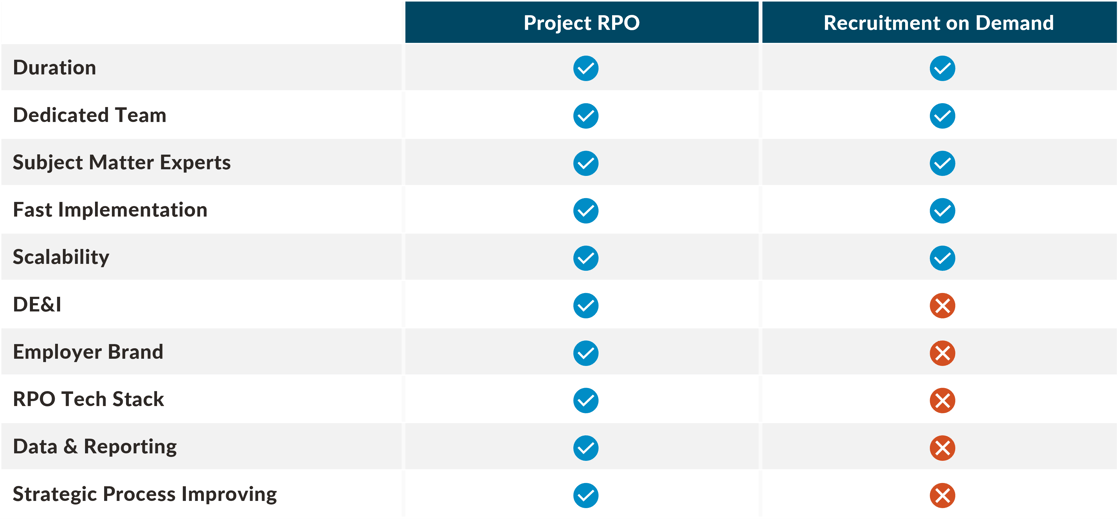The escalating competition for talent is driving organizations to adopt more forward-thinking and strategic approaches. Organizations are challenged to select the most effective recruitment strategies, often discovering that internal processes, while seemingly sufficient, reveal inefficiencies and missed opportunities. Traditional, reactive recruitment methods can be slow and costly while straining internal HR teams.
In response to these challenges, Project Recruitment Process Outsourcing (RPO) and Recruitment on Demand (RoD) have emerged as two standout solutions. Understanding the key differences and benefits of these approaches is essential for making informed decisions about your talent acquisition strategy. This blog post delves into the core distinctions and advantages of Project RPO and Recruitment on Demand, highlighting the value each can bring to your organization.
What Is Project RPO?
With Project RPO, organizations can outsource all or part of their talent operations for a set period. This includes support for employer branding, DE&I initiatives, sourcing, outreach, screening, assessments, interview scheduling, reference checks, selection, onboarding, and more. Project RPO is ideal for businesses facing significant hiring demands or undergoing changes, such as expansions, acquisitions, or seasonal spikes.
Project RPO teams can be scaled to meet fluctuating demands, and the engagement length is aligned with the project duration. This flexibility allows Project RPO to serve as a short-term solution or evolve into a long-term partnership. Often, businesses use Project RPO to evaluate its benefits, potentially extending the engagement or transitioning to a comprehensive RPO relationship.
Benefits of Project RPO include:
- Efficiency: Streamlined processes with dedicated resources focused on your project.
- Expertise: Access to specialized recruiters and industry expertise.
- Cost Predictability: Fixed costs associated with the project’s scope and timeline.
- Scalability: Ability to scale up or down based on project needs.
What Is Recruitment on Demand?
In a Recruitment on Demand model, sourcers and recruiters are temporarily assigned to the client organization on a weekly or monthly basis, tailored to the contract design. Often, these professionals are assigned based on industry-specific expertise. Similar to Project RPO, Recruitment on Demand allows for the scaling of recruiting teams to meet changing demands. This model supplements your in-house HR and recruitment efforts with minimal administrative burden, focusing solely on sourcing and recruitment.
Benefits of Recruitment on Demand include:
- Agility: Quickly ramp up or down based on immediate needs.
- Cost-Effective: Only pay for the services you use, reducing overhead costs.
- Immediate Support: Rapid access to recruitment expertise and resources when needed.
- Reduced Burden: Helps alleviate the workload on your internal HR team during busy times.
Project RPO vs. Recruitment on Demand: Key Differences

Project RPO and Recruitment on Demand are scalable models designed to address significant hiring challenges and deliver rapid results under tight time constraints. Both models offer quick implementation, short ramp-up times, and dedicated teams to manage sudden hiring spikes and fill difficult roles. They are also ideal for leaders who want to explore outsourced talent solutions for the first time or are hesitant to fully outsource their internal processes.
Scope
Project RPO provides an end-to-end solution, while Recruitment on Demand supports only the sourcing and recruitment stages.
Transformational Value
Project RPO includes services like employer branding, DE&I support, strategic insights, and tech tools, deeply embedding within your organization to deliver strategic improvements. Recruitment on Demand temporarily increases your sourcer and recruiter headcount but doesn't offer these additional services.
Data and Reporting
Project RPO incorporates data and reporting, measuring success by metrics like time-to-fill, quality of hire, and offer-to-acceptance ratios. These metrics can result in permanent process improvements and efficiencies, resulting in a lasting impact on your talent infrastructure.
Choosing the Right Model for Your Needs
Both Project RPO and Recruitment on Demand offer unique benefits tailored to different recruitment scenarios. The choice between the two depends on your organization's specific needs and goals. Consider these factors to make an informed decision:
- Volume and Frequency of Hiring: High volume with a defined project favors Project RPO, while sporadic hiring favors Recruitment on Demand.
- Budget Constraints: Recruitment on Demand can be more cost-effective for irregular hiring needs.
- Project Complexity: For complex, large-scale hiring projects, Project RPO provides comprehensive support.
- Internal Resources: Assess your internal HR team’s capacity and expertise to handle varying hiring demands
Empowering Your Recruitment Strategy
At LevelUP HCS, we specialize in tailored recruitment solutions. If you are one of the many leaders interested in finding out what a Project RPO or Recruitment on demand program can add to your company, our talent solution experts are available to discuss potential solutions and strategies to address your challenges. Connect with us at this link.





